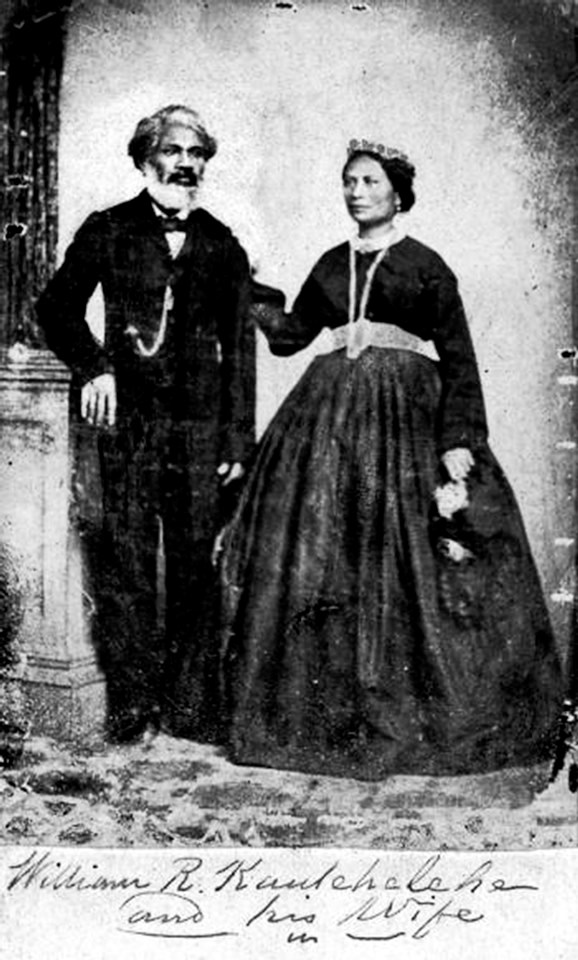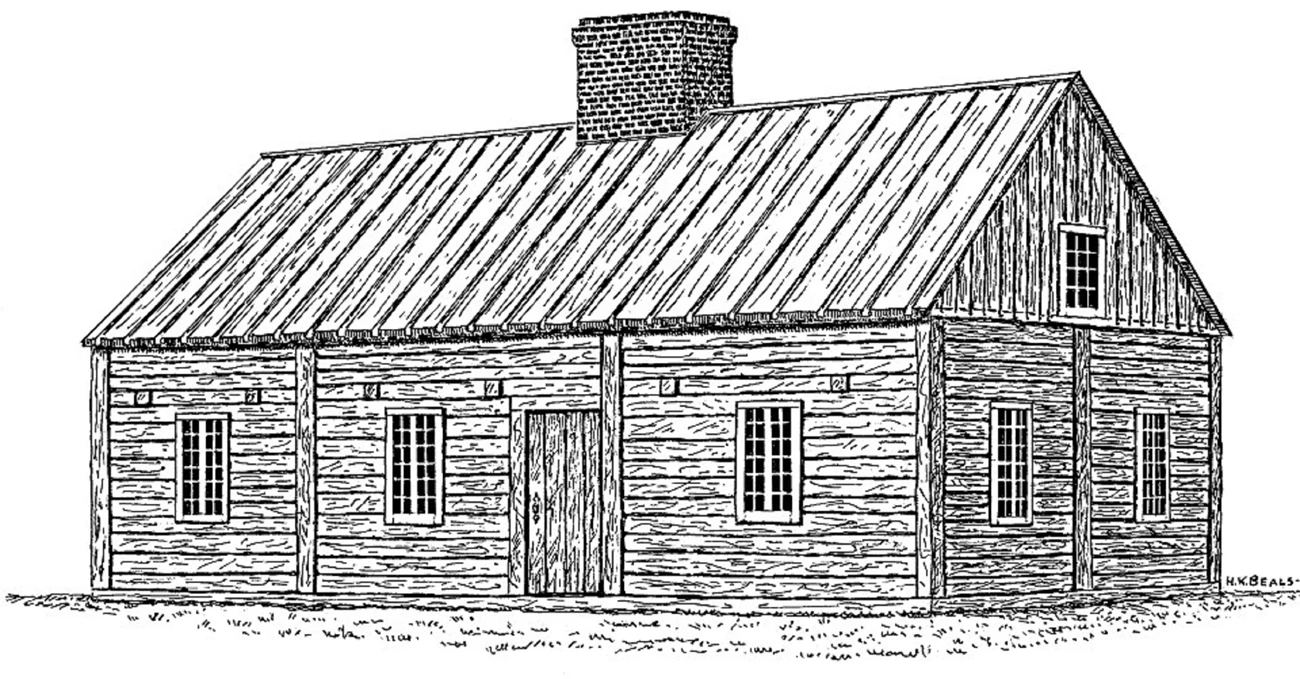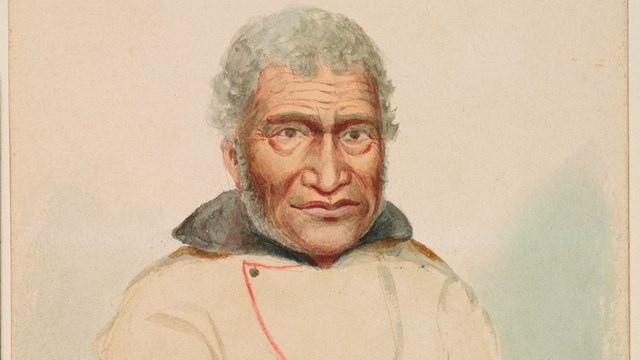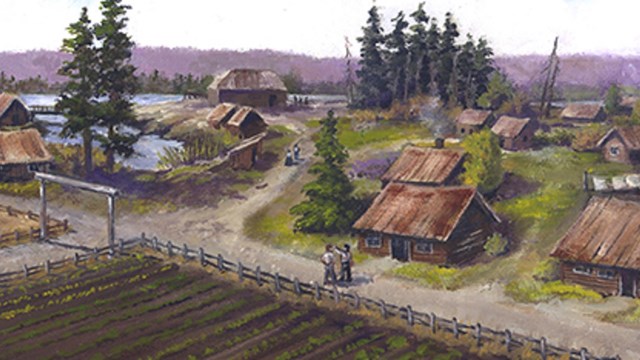Last updated: May 25, 2024
Article
William Kaulehelehe and Mary Kaai

Image #67874 courtesy of the BC Archives
William Kaulehelehe and Mary Kaai stand at a fascinating intersection of two major activities that drew Native Hawaiians to the Pacific Northwest: the fur trade and missionary endeavors. In addition to working in a variety of positions at fur trade posts like the Hudson’s Bay Company’s Fort Vancouver, some Hawaiians traveled with American missionaries looking to establish bases for missionary activity in the Northwest, coming either directly from the Hawaiian Kingdom or recruited from Fort Vancouver.
Hawaiians at Fort Vancouver
By 1845—the year Kaulehelehe and Kaai arrived at Fort Vancouver—Native Hawaiians were a well-established presence, making up almost a third of Fort Vancouver's workforce. When the HBC took over operations in the area from its predecessor, the North West Company, in 1821 they gained its employees, including 36 Native Hawaiians. These workers helped to build and establish Fort Vancouver, and they and an increasing number of Hawaiian employees took on a variety of roles at the growing outpost. Whether they worked in the fort’s sawmill or farm, as boat pilots, cooks, carpenters, or any other role, Native Hawaiians were integral to HBC operations. However, the relationship between Native Hawaiian employees and the Hudson’s Bay Company (HBC) could be strained. Living far from home in small cabins in Fort Vancouver’s employee Village, contending with long hours, demanding work, and little ability to protest or appeal, Hawaiians soon became frustrated with their employers. HBC sources reveal a concern that Hawaiian employees were sharing knowledge of local trade with competitors or even deserting from the HBC in order to aid rival fur trade companies, such as those run by American traders like Nathaniel Wyeth, who recruited Native Hawaiians from Fort Vancouver in the 1830s.
Even those Hawaiians who did not desert could come into conflict with those in fort leadership who desired to exert a greater level control over their daily life. The opinions of visiting missionaries, both Americans on their way to establish their own missions and English clergy assigned to the fort, were often critical of Hawaiian employees for not complying with their expectations of religious observance. These impressions were undoubtedly filtered through the missionaries’ preconceived notions of “acceptable” behavior and ways of living, and at least in some cases, outright racial and cultural prejudice against Hawaiians or a desire to criticize the HBC by portraying its employees as morally bankrupt.
Visiting American missionary Alvin F. Waller claimed in 1842 that the “condition” of Hawaiian employees was “deplorable,” as many spent Sundays—the only day the HBC did not require them to work—attending to their homes and families rather than attending formal Christian religious services. British minister Herbert Beaver, who was assigned by the HBC to conduct services at the fort, came to similar conclusions as the Americans and recommended that the HBC hire a Hawaiian pastor. Although he referenced the language barrier as a primary reason, his notorious prejudice may have also influenced his recommendation, as Beaver had entirely refused to conduct any religious services or ministry for Hawaiians while at the fort even when requested to do so. Such impressions, while representing more of the missionaries’ own beliefs than a full picture of Hawaiian communities in the Village, nevertheless demonstrate that potentially influential visitors to Fort Vancouver took issue with Hawaiian employees and hoped to enforce compliance with their own standards of behavior.
In the summer of 1844, Fort Vancouver’s Chief Factor Dr. John McLoughlin wrote a letter to the HBC office on O'ahu requesting a Hawaiian chaplain to “read the Scriptures and assemble his people for public worship.” In addition to preaching, this chaplain would be expected to serve as a teacher, providing general education and instruction in the Hawaiians’ own language. McLoughlin hoped that this would help curb what he referred to as “corruptions” among the Native Hawaiians: drinking, fighting, and gambling.
Since we do not have any direct accounts from the Hawaiians regarding the accusation of “corruptions,” it is difficult to know the full story or extent of these issues, but it is clear that tensions existed, and McLoughlin felt unequipped to resolve them, perhaps due to cultural or language barriers or a lack of resources. As the administrator of Fort Vancouver, McLoughlin would have also been aware of instances of desertion among Native Hawaiians and the criticism from missionaries. His request for someone who was both a preacher and teacher seemed to reflect a desire to simultaneously address the concerns from the HBC administrators and visiting clergy, creating a more compliant workforce that would then be less likely to desert.
McLoughlin’s request was received by G.P. Judd, an American missionary living in the Hawaiian Kingdom. Judd recommended 36-year-old William R. Kaulehelehe, as a “faithful, industrious Skillful Teacher.” Kaulehelehe’s wife, Mary Kaai, 23, was also “highly recommended.” The couple departed the islands on May 15, 1845, and arrived at Fort Vancouver five weeks later.
William Kaulehelehe
The historical record reveals little about Kaulehelehe’s life in Hawai’i, but we do know that by 1845, he was prominent and well-respected enough to earn Judd’s recommendation, despite not being an ordained minister. A Hawaiian newspaper, Ka Elele Hawai’i (The Hawaiian Messenger), reported on Kaulehelehe and Kaai’s departure, referring to them both as “missionaries” who would serve as “teachers.” In accordance with this missionary title, upon his arrival Kaulehelehe established the “Owyhee Church” in a building inside Fort Vancouver, reporting about 20 to 40 attendees within a few months.
NPS Photo
Kaulehelehe at Fort Vancouver: Supervisor or Advocate?
Kaulehelehe’s mission—to provide spiritual and educational guidance to Hawaiians at Fort Vancouver—did not always fit with the expectations or lived reality of his flock. While the HBC saw the introduction of a Hawaiian chaplain as a way to ensure compliance from their workers, many Hawaiians hoped Kaulehelehe would be a much-needed mediator who could advocate for them to company leadership. In a letter to Judd sent from Fort Vancouver, Kaulehelehe described aggrieved Hawaiian workers, “repeatedly abused by the white people without any cause,” who hoped Kaulehelehe had “come as an officer” from the Hawaiian government to “settle their difficulties.”An HBC employee himself, Kaulehelehe believed that he had no authority to act as a mediator when he had been sent to preach and teach. These disagreements complicated Kaulehelehe’s stated goals, and his congregation at the Owyhee Church remained small. In addition, teaching proved difficult, since the HBC schedule left only Sundays—reserved for religious instruction—as a day of rest. Tensions between Kaulehelehe and the Hawaiian population at the fort became so high that Kaulehelehe and Mary Kaai were forced to move from their house in the employee Village, where most Hawaiians lived, to a residence within the fort’s walls, joining resident Anglican clergy and Catholic priests as the only non-administrators residing within the stockade.
Although we do not have any records to suggest that Kaulehelehe became the intermediary many Hawaiians had hoped, he was willing to adjust his ministry in smaller ways. According to a contemporary, he “preached to the Kanakas [a term for Hawaiians] in their camp among their houses” in addition to continuing Sunday services in the fort, an important step in making his work more accessible given the employees’ lack of spare time. Perhaps such compromises, in addition to the shrinking size of the Village after the gold rushes in California drew many HBC employees south, influenced Kaulehelehe and Kaai’s move back to the Village, where they had resettled by 1850.
The next decade brought an end to HBC control of Fort Vancouver, leaving the Hawaiian workers, like all other HBC employees, to find other employment in what had become United States territory or relocate to Canada. With the Oregon Treaty of 1846 ending Britain’s claims to the area and the US Army’s arrival in 1849, HBC activities in the region ceased in 1860 as the company moved their base of operations north to Fort Victoria in what is now British Columbia.
In the face of this political upheaval, Kaulehelehe and Mary Kaai decided to remain in their home in the Fort Vancouver Village. However, in 1860, against Kaulehelehe’s protests, the Army slated the couple’s house for demolition, forcibly removed them, and set fire to their home. Kaulehelehe and Kaai relocated to Fort Victoria and settled in a neighborhood known as “Kanaka Row,” a community that included many Native Hawaiians, mostly HBC employees and their families.
Later Life
Revealing significant, enduring connections between the Hawaiian Islands and expatriate communities like Fort Victoria’s Kanaka Row, in 1863 Kaulehelehe compiled a directory listing contemporary Hawaiian communities from Oregon to British Columbia, publishing it in Ka Nuepepa Kuokoa (The Independent Newspaper), a publication to which Kaulehelehe himself subscribed. Kaulehelehe hoped that his directory would limit misdirected communications and allow Hawaiians to read the “loving sentiments of their friends” even as they remained separated by the Pacific Ocean. Events like the end of HBC operations in the Oregon Territory and the lure of California’s goldfields had also scattered those Hawaiians on the North American continent. Witnessing those events personally from Fort Vancouver, Kaulehelehe understood the need to ensure that communication could continue to connect friends and family dispersed over long distances.In Victoria, Kaulehelehe worked as a Hudson’s Bay Company clerk and interpreter. He was still employed by the HBC in 1869, at which time he served as a court translator for Peter Kakua, a former HBC employee who was standing trial for murder. Kaulehelehe died on June 22, 1874 at the age of 65 and was buried in Ross Bay Cemetery.
Mary Kaai
Uncovering the experiences of Native Hawaiian women of the HBC era is often extremely difficult. Mary Kaai is one of only two Hawaiian women whose names appear in Fort Vancouver records (the other being a woman known only as Betty, who lived with a Hawaiian worker named John Kie). Both have been mainly identified by their relationship to male employees. The vast majority of Hawaiians who worked at HBC locations were men, who often married local Indigenous women.However, with the details available we can reconstruct some idea of who Mary Kaai was. Judd’s description of her as a person “highly recommended” to him meant that she had achieved standing within the Hawaiian missionary community by the age of 23. Arriving with Kaulehelehe at Fort Vancouver, Kaai would have confronted the same challenges of moving almost three thousand miles to a foreign land and facing a sometimes unwelcoming community. After their displacement and relocation to Fort Victoria in 1860, Kaai was active in the Native Hawaiian community of Victoria’s Kanaka Row. At some point, the couple adopted a daughter named Mary Opio, also Native Hawaiian, who was 15 at the time of her death in 1864.
Although we do not have direct sources on the nature of Kaulehelehe and Kaai’s personal lives, some evidence points to their close partnership. Mary Kaai passed away on December 31, 1865 at the age of 43, and, over the next year, Kaulehelehe composed a kanikau (funeral chant) in her honor, publishing it in Ka Nupepa Kuakoa in November of the following year. The piece was featured on the front page of the November 3rd edition. At 355 lines, the chant is a deeply emotional funeral song, inviting Mary’s soul to once again visit places throughout the Northwest that were dear to her, as former neighbors—Hawaiian and Northwest Indigenous women who lived on Kanaka Row—express their love for the departed.

NPS Photo
Legacy: Community and Conflict
The stories of William Kaulehelehe and Mary Kaai reveal the complexity, conflict, and community that characterized Native Hawaiian life in the Northwest. Although they never returned to live in the islands, the couple remained connected to Hawaiian communities at home and abroad through strong transnational networks.Today, visitors to Fort Vancouver National Historic Site can explore the stories of Kaulehelehe and Kaai, as well as those of the many other Native Hawaiians who lived and worked at Fort Vancouver. The Fort Vancouver Visitor Center includes exhibits and a park film that invite visitors to learn more about the Native Hawaiian community at this HBC outpost, including how their legacy influences contemporary artists. The reconstructed fort depicts Fort Vancouver as it would have looked in 1845, the year that Kaulehelehe and Kaai arrived. Stepping through the gates and touring reconstructed buildings, one can imagine how the couple would have felt arriving in this new place thousands of miles from their home. Visitors can walk to the Village and see two reconstructed cabins like those in which Kauelehelehe and Kaai would have lived.
Although their house has not yet been reconstructed, archaeological work continues to uncover clues about their daily life. The artifacts found at their former house site tell the story of Kaulehelehe and Kaai creating a new home for themselves using objects acquired through trade from all parts of the world, such as the metal fragments of a small container stamped with the coat of arms of the British monarchy, or ceramic jar that would have held preserved ginger from China. Like Kaulehelehe’s communications to Hawai’i or the expatriate Hawaiian communities scattered throughout the Northwest, these objects reveal the enduring global connections of trade and travel that carry their legacy to the present day.
Further Reading
“Hawaiian missionaries William Kaulehelehe and Merelina Kaulehelehe go to Oregon, 1845.” Ka Elele Hawai’i. Published 3 June 1845. Translated and published digitally 15 May 2019, d. Nupepa Hawai’i. Hawaiian missionaries William Kaulehelehe and Merelina Kaulehelehe go to Oregon, 1845. | nupepa (nupepa-hawaii.com).Barman, Jean and Bruce MacIntyre Watson. Leaving Paradise, Indigenous Hawaiians in the Pacific Northwest, 1787-1898. Honolulu: University of Hawai’i Press, 2006.
Chang, David A. “Critical Indigenous methodology and the problems of history: Love and death beyond boundaries in Victorian British Columbia.” In The Routledge Handbook of Critical Indigenous Studies. Edited by Brendan Hokowhitu, Aileen Moreton-Robinson, Linda Tuhiwai-Smith, et al. London: Routledge, 2021.
Deur, Douglas. An Ethnohistorical Overview of Groups with Ties to Fort Vancouver National Historic Site. Seattle: Pacific West Region, National Park Service and the College of Forest Resources, 2012.
Kaulehele, William R. “A Letter from Victoria.” Ka Nupepa Kuakoa. Published 6 June 1863. Translated and published digitally by the Bishop Museum. Four Corners of the Earth – Bishop Museum Blog.
Klan, Yvonne Mearns. “Kanaka William.” The Beaver. Spring 1979: 38-43.
Morris, Nancy and Robert Benedetto. Nā Kahu: Portraits of Native Hawaiian Pastors at Home and Abroad, 1820-1900. Honolulu: University of Hawai’i Press, 2019.

Hawaiians at Fort Vancouver
Learn more about the history of Hawaiians at Fort Vancouver and their modern-day legacy at Fort Vancouver NHS.

The Fort Vancouver Village
Learn more about the Fort Vancouver Village, where Mary Kaai and William Kaulehelehe lived.
